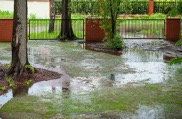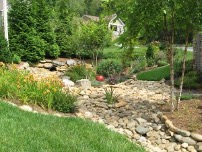
04 Jul Effective Drainage Solutions for Flood-Prone Areas
Flood-prone areas face unique challenges that can cause significant damage to properties and landscapes. Persistent flooding can lead to soil erosion, foundation issues, and the loss of valuable plants and trees. The need for effective drainage solutions becomes crucial in such environments to divert excess water and protect your property.
Knoxville, Tennessee, often experiences substantial rainfall, making it essential for residents to have robust drainage systems in place. Fortunately, a variety of drainage solutions can help manage water flow and reduce the risk of flooding. From simple yard grading to more complex French drains and sump pumps, these techniques can safeguard your landscape and home.
Understanding the importance of proper drainage is the first step toward protecting your property from the adverse effects of flooding. By implementing the right solutions, you can enjoy a beautiful, healthy landscape while minimizing the risks associated with excessive water. Stay with us as we delve into the world of drainage systems and uncover the best strategies for keeping flood-prone areas safe and dry.
Importance of Proper Drainage Systems
Proper drainage systems are essential for homes in flood-prone areas. Without an effective drainage system, homes risk suffering from water damage, foundation problems, and unhealthy landscape conditions. Implementing suitable drainage solutions helps channel excess water away from your property, preventing these issues and ensuring a safer, more stable environment.
Identifying Drainage Problems
Identifying drainage problems early on can save homeowners from significant issues later. Common signs of poor drainage include standing water, damp spots in the yard, water stains on walls, and musty odors indicating mold growth. Recognizing these signs allows for timely intervention.
Conduct a thorough inspection of your property, particularly after heavy rain, to look for these warning signs. Check the areas around your home’s foundation, walkways, driveways, and any low-lying spots where water tends to accumulate. Once you identify problem areas, you can begin exploring suitable drainage solutions.
French Drains
A French drain is a simple yet effective solution for redirecting water away from your property. It consists of a trench filled with gravel and a perforated pipe that channels water away from affected areas. French drains are particularly useful for preventing water from pooling around the foundation of your home.
French drains can be installed in problem areas throughout your yard. The trench is dug to a specific depth and grade to ensure proper water flow. The perforated pipe is then placed in the trench and covered with gravel. This system allows water to enter the pipe and be carried away from your home, reducing the risk of flooding and water damage.
Sump Pumps
Sump pumps are another effective drainage solution for flood-prone areas, especially for homes with basements. These devices are installed in a sump pit, typically located in the basement. When water accumulates in the pit, the sump pump activates and channels water away from your home through a discharge pipe.
Sump pumps come in various types, including submersible and pedestal models. Submersible pumps are installed inside the sump pit and are designed to handle larger volumes of water. Pedestal pumps, on the other hand, have the motor mounted above the pit, making them easier to access for maintenance.
Surface Drainage Systems
Surface drainage systems are designed to manage water at ground level. These systems include swales, catch basins, and channel drains, which work together to direct water away from your property’s surface.
Swales are shallow, sloped channels that collect and move water away from problem areas. They can be natural or man-made and are often lined with grass or other vegetation to slow water flow and promote infiltration. Catch basins are installed at low points in your yard to collect excess water, which is then directed to underground pipes for removal. Channel drains, typically installed along driveways and walkways, capture and redirect surface water away from your property.
Yard Grading
Yard grading is a critical aspect of effective drainage. Grading involves reshaping the slope of your yard to promote proper water runoff away from your home. Poorly graded yards often lead to water pooling around the foundation, increasing the risk of flooding and damage.
Professional grading services can help assess your yard’s current slope and make necessary adjustments. The goal is to create a gentle slope away from your home, ensuring water flows naturally toward designated drainage areas. Proper grading can significantly reduce the likelihood of standing water and other drainage issues.
Dry Wells
Dry wells are underground structures designed to collect and disperse excess water. They consist of a large, porous container buried in the ground and covered with soil. Water is directed into the dry well, where it slowly infiltrates the surrounding soil.
Dry wells are particularly useful for managing runoff from roofs, downspouts, and other areas where water tends to accumulate. They help prevent surface flooding and reduce the burden on other drainage systems. Installing a dry well requires careful planning to ensure it is placed in an area where water can easily disperse without causing issues.
Permeable Paving
Permeable paving is a sustainable drainage solution that allows water to pass through the paving material, reducing runoff and promoting infiltration. This type of pavement is made from porous materials like permeable concrete, asphalt, or pavers.
Permeable paving can be used in driveways, walkways, patios, and other hardscape areas. It helps manage stormwater by allowing it to seep through the surface, reducing the risk of flooding and soil erosion. Additionally, permeable paving materials are often more environmentally friendly, as they reduce the need for extensive drainage infrastructure.
Rain Gardens
Rain gardens are shallow, planted depressions designed to capture and absorb runoff. They are typically filled with native plants and grasses that can tolerate both wet and dry conditions.
Installing a rain garden in a low-lying area of your yard can effectively manage stormwater. The plants in the rain garden help slow down water flow, allowing it to infiltrate the soil and recharge groundwater supplies. Rain gardens are not only functional but also add aesthetic value to your landscape.
Regular Maintenance
Maintaining your drainage systems is crucial to their long-term effectiveness. Regularly inspect and clean gutters, downspouts, and drainage pipes to ensure they are free of debris and functioning properly. Check for signs of wear or damage and make necessary repairs promptly.
French drains and sump pumps also require periodic maintenance. For French drains, inspect the gravel and pipe for clogs and clean as needed. Sump pumps should be tested regularly to ensure they activate when needed and are free of obstructions. Surface drains, catch basins, and swales should be cleared of debris to maintain proper water flow.
Choosing the Right Solution
Selecting the appropriate drainage solution for your property depends on several factors, including the severity of the flooding, the layout of your yard, and your specific needs. Consulting with a drainage professional can help determine the best approach for your situation.
Incorporating a combination of these solutions may be necessary for optimal results. For example, a combination of yard grading, French drains, and rain gardens can effectively manage water flow and reduce the risk of flooding. Customizing your drainage strategy ensures that your property remains protected from water damage.
Effective drainage solutions are essential for maintaining the integrity and safety of your home and landscape. By implementing the appropriate techniques and maintaining your systems, you can protect your property from the adverse effects of flooding and waterlogging.
Gutter and Downspout Systems
Gutters and downspouts play a vital role in managing roof runoff. They channel rainwater away from your home’s foundation and prevent water from pooling around the base, which could lead to flooding or structural damage.
Install seamless gutters to reduce the risk of leaks and ensure they are large enough to handle heavy rainfall. Downspouts should extend at least three feet from your home. Use extensions or splash blocks to direct water further away from the foundation. Regularly clean your gutters to remove debris that could cause blockages and impede water flow.
Catch Basins and Dry Creek Beds
Catch basins and dry creek beds are excellent options for collecting and diverting surface water. Catch basins are underground receptacles that collect runoff and channel it away through a network of pipes.
Dry creek beds are decorative yet functional landscape features. These shallow, rock-lined channels mimic a natural stream and guide water away from areas prone to flooding. Both solutions help manage heavy rainfall and reduce the risk of waterlogging in your yard.
Subsurface Drainage Systems
Subsurface drainage systems, like weeping tiles and perforated pipes, are installed below ground to manage excess water. These systems collect underground water and direct it away from the foundation or other problem areas.
Weeping tiles are particularly useful for properties with high water tables or poor soil drainage. The perforated pipes allow water to enter and be carried away, preventing it from saturating the ground. Installing a subsurface drainage system can significantly enhance your property’s resilience to flooding.
Installing Berms
Berms are raised areas of soil that redirect water flow and prevent flooding. Used effectively, they can protect your home by creating barriers that channel water away from vulnerable areas.
Design berms to blend with your landscape, using native plants and grasses to stabilize the soil. Properly placed berms can control runoff, reduce erosion, and create attractive features in your yard.
Utilizing Vegetative Swales
Vegetative swales are gently sloped ditches filled with plants that capture, slow, and filter runoff. They are an eco-friendly solution for managing stormwater and preventing erosion.
Choose native, deep-rooted plants for swales, as they help absorb water and improve soil stability. These plants also provide habitat for local wildlife, enhancing the ecological value of your property. Swales are a sustainable method to manage water flow and improve drainage.
Ensuring Effective Soil Management
Soil composition and health play a significant role in drainage. Soil with good structure and organic content absorbs and drains water efficiently, reducing the risk of waterlogging.
Regularly test your soil to determine its composition and pH levels. Amend your soil with organic matter, such as compost or mulch, to improve its ability to retain and drain water. Avoid compacting the soil, as this can hinder water infiltration. Proper soil management supports healthy plant growth and enhances your property’s drainage capacity.
Installing Drainage Trenches
Drainage trenches are narrow, excavated channels filled with gravel that redirect surface water away from problem areas. They are simple to install and effective for managing runoff in specific parts of your yard.
Dig trenches in areas where water tends to collect and connect them to a suitable outlet, such as a swale or a storm drain. Fill the trenches with gravel and cover them with permeable fabric to prevent soil from clogging the gravel. Drainage trenches provide a straightforward solution for improving water flow and preventing surface flooding.
Using Green Roofs
Green roofs, or living roofs, are covered with vegetation and a growing medium, providing various environmental benefits. They absorb rainwater, reduce runoff, and improve insulation.
Consider installing a green roof on your home or garden structure. It helps manage stormwater by capturing and utilizing rainfall. Green roofs also provide habitat for local wildlife and improve air quality. While installation might require professional assistance, green roofs offer a sustainable approach to enhancing your property’s drainage capabilities.
Building Proper Driveway and Walkway Drainage
Driveways and walkways can contribute to drainage problems if they do not properly manage water runoff. Ensuring these areas have adequate drainage prevents water from pooling and flooding adjacent areas.
Use permeable paving materials for driveways and walkways, which allow water to seep through and reduce runoff. Incorporate drainage channels or swales along the edges to direct water away. Properly graded drive and walkways ensure water flows toward designated drainage systems, not your home.
Incorporating Rainwater Harvesting Systems
Rainwater harvesting systems collect and store runoff from roofs for later use. These systems reduce the volume of water flowing into drainage systems and help manage stormwater.
Install rain barrels or larger cisterns to capture rainwater from your roof. Use this collected water for irrigation or other non-potable purposes. Rainwater harvesting is an environmentally friendly method to control runoff, conserve water, and enhance your property’s drainage.
Maintaining Drainage Features
Regular maintenance of your drainage features ensures their effectiveness and longevity. Neglecting maintenance can lead to blockages, system failures, and increased flooding risks.
Inspect all drainage elements regularly, especially after heavy rain. Clear debris from gutters, downspouts, catch basins, and swales. Replace damaged components and repair any signs of wear. Consistent maintenance keeps your drainage systems functioning properly and protects your property from water damage.
Emergency Measures for Flooding
Despite having effective drainage solutions in place, extreme weather events can still lead to flooding. Being prepared for emergencies minimizes damage and ensures a swift response.
Keep sandbags or other barriers on hand to block floodwaters from entering your home. Have a sump pump ready in case of basement flooding. Create an emergency plan that includes contact information for local services and steps to protect your property. Staying prepared helps manage unexpected flooding and maintain the safety of your home.
Educating Yourself on Local Regulations
Understanding local regulations and guidelines regarding drainage can help ensure your solutions comply with legal requirements and environmental standards.
Research local building codes and drainage ordinances. Consult with professionals to ensure your drainage systems meet all necessary regulations. Being informed about local guidelines helps you implement effective drainage solutions while staying compliant with legal standards.
Protect Your Home with Effective Drainage Solutions
Managing drainage effectively is essential for protecting your home from the damaging effects of flooding and waterlogging. You can create a resilient and sustainable environment by understanding your property’s unique needs and implementing a combination of solutions such as gutters, downspouts, permeable pavers, vegetation swales, and rainwater harvesting systems.
Ensuring proper grading, utilizing retention ponds, and installing subsurface drainage systems further enhance your property’s ability to handle heavy rainfall. Regular maintenance and understanding local regulations are crucial steps in keeping your drainage systems functioning well and legally compliant.
Incorporating natural features like wetlands and bioswales, along with modern technology for monitoring, helps create a comprehensive strategy. Educating your community and adapting to climate change will strengthen your efforts.
Ready to protect your home from flooding and enhance your drainage systems? Visit Rainscapes for expert guidance and top-quality solutions tailored to your needs. Don’t wait—secure your home against water damage today.




Sorry, the comment form is closed at this time.